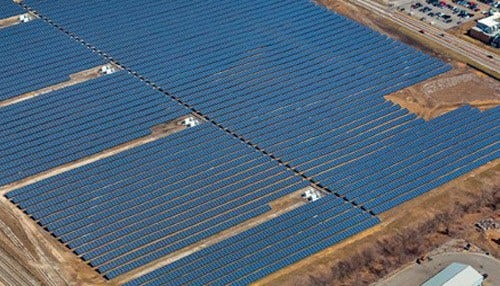Governor’s Award Win A Success Story for Partners

Subscriber Benefit
As a subscriber you can listen to articles at work, in the car, or while you work out. Subscribe NowThis fall, an Indianapolis-area solar project received kudos at the state level for its ambitious and innovative reuse of a former EPA Superfund Site. Now the company that led the project says the Maywood Solar Farm is setting a great example for similarly difficult locations.
Strong incentives and an out-of-the-box design concept are earning the lead partners in the Maywood Solar Farm project both interest and praise. Solar module manufacturer Hanwha Q Cells led the project after site owner Vertellus Specialties received a rebate award from IPL’s renewable energy program. Ultimately, the Maywood Solar Farm was completed without additional federal, state, local or corporate incentives.
Geoff Underwood, utility scale developer for Hanhwha Q Cells, says the affirmations are particularly rewarding given the challenges presented by the former Reilly Tar and Chemical site. After many years of EPA remediation, the soil at the 43-acre location still posed potential problems. “There were two overall issues within the project that were unknowns and had very expensive solutions originally proffered for them, and that is that at the southern portion of the site was a constructed landfill for the materials that were on the site that was done as part of the EPA mitigation, and then the rest of the site had contaminants throughout the soil, but they were largely unknown or uncollected, so there was a concern of uncovering those materials.” Underwood says, rather than use a ballasted racking system for the solar modules, a very cost intensive option, Hanwha opted for galvanized steel poles throughout the site, piercing the ground in very small spots and thus moving minimal soil.
Completed in 2014, the Maywood Solar Farm’s 10.8 megawatt system now provides power to IPL at a rate of 14-million KWH per year, roughly enough to power 2,000 residences. The program life is 15 years, but the equipment life is between 25 and 35 years and with an expectation to extend the project under another contract.
“We gained a lot of valuable experience dealing with larger solar-type installations, in terms of both studying them and adjusting the operation of our distribution system to accommodate them. Our guys learned a lot and will be well prepared for anything that might come down the pike along these lines,” says John Haselden, a principal engineer with IPL.
“We continue to seek out these types of sites,” adds Underwood. “We’re trying to find the right collection of circumstances that will make this palatable and achievable. I think one of the more important lessons that came out of this project was that you can construct these projects with little to no premium, and if that’s true then there’s a real opportunity for utilities or others to develop programs for these types of developments. ”
Additional partners on the Maywood Solar Farm were the Indiana Department of Environmental Management, PNC Bank and August Mack Environmental Consulting.
“The Governor’s Award is in some ways a capstone of recognition on the project,” says Underwood. “It is very satisfying to know that there’s a local recognition, a state level of recognition and a federal level of recognition, because I do think what we did has the potential to encourage others to take on these kinds of projects.”
The other two facilities recognized with the Governor’s Award for Environmental Excellence are the General Motors Fort Wayne Assembly Plant and Raytheon ISS Indianapolis.
Geoff Underwood, utility scale developer for Hanwha Q Cells, would like to see more communities consider the double benefits of a project like Maywood Solar Farm.
